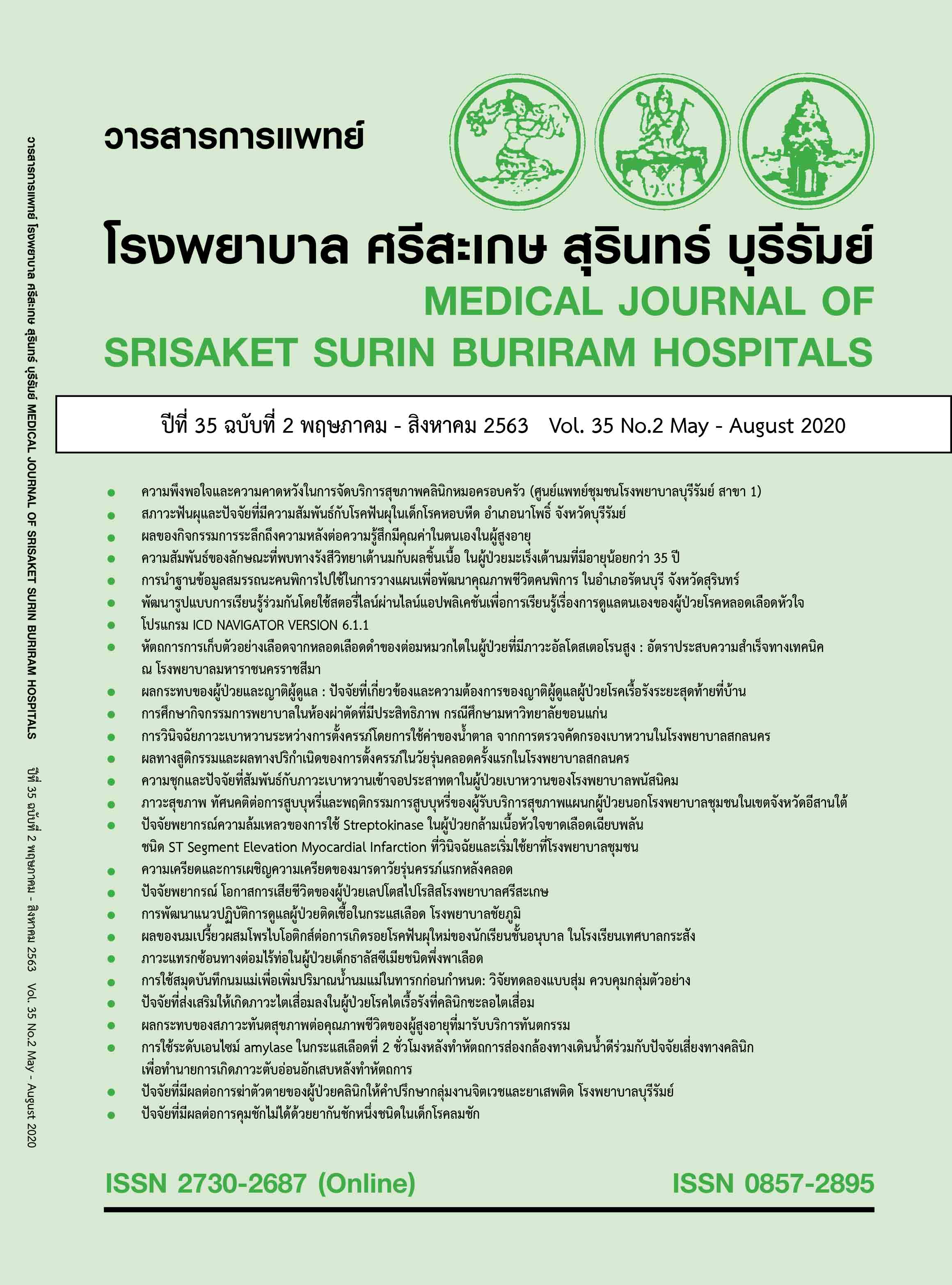ปัจจัยที่มีผลต่อการคุมชักไม่ได้ด้วยยากันชักหนึ่งชนิด
Main Article Content
บทคัดย่อ
หลักการและเหตุผล: โรคลมชักในเด็กเป็นโรงทางระบบประสาทที่พบได้บ่อย การรักษาโรคลมชักปัจจุบันมีหลากหลาย แต่การรักษาหลักยังเป็นการรักษาด้วยยา โดยพบว่าผู้ป่วยร้อยละ60-70 สามารถคุมอาการชักได้ด้วยยากันชักเพียงชนิดเดียว อย่างไรก็ตามร้อยละ 30-40 ของเด็กโรคลมชักไม่สามารถคุมอาการชักด้วยยากันชักชนิดเดียวได้ จำเป็นต้องได้รับยากันชักชนิดที่สองในการคุมชัก การศึกษาครั้งนี้มีวัตถุประสงค์เพื่อหาปัจจัยที่มีผลต่อการใช้ยากันชักมากกว่าหนึ่งชนิดเพื่อเป็นประโยชน์ในการใช้ประเมินการให้ยากันชักตัวที่สองเร็วขึ้นเพื่อควบคุมอาการชักได้ดียิ่งขึ้น
วัตถุประสงค์: ศึกษาปัจจัยที่มีผลต่อการคุมชักไม่ได้ด้วยยากันชักหนึ่งชนิด
วิธีการศึกษา: เป็นการศึกษา Retrospective cohort study ในผู้ป่วยเด็กอายุน้อยกว่า15 ปี ที่ได้รับการวินิจฉัยเป็นโรคลมชักที่เข้ารับการรักษาในโรงพยาบาลสุรินทร์ระยะเวลาที่ทำการศึกษาตั้งแต่ เดือน มกราคม พ.ศ. 2559ถึงเดือน ธันวาคม พ.ศ. 2561 รวม 3 ปี รวบรวมข้อมูลจากเวชระเบียนผู้ป่วยใน เวชระเบียนผู้ป่วยนอก และจากใบส่งตัวของโรงพยาบาลที่ได้ส่งตัวผู้ป่วยมารับการรักษาที่โรงพยาบาลสุรินทร์ โดยศึกษาลักษณะทางคลินิก ผลการตรวจร่างกายทางระบบประสาท ผลการตรวจคลื่นไฟฟ้าสมอง ผลการตรวจเอ็กซเรย์สมองผลการรักษา และนำมาหาปัจจัยที่มีผลต่อการใช้ยากันชักมากกว่าหนึ่งชนิดในการคุมชัก
ผลการรักษา: จำนวนผู้ป่วยทั้งหมด 157 ราย โดยพบว่ากลุ่มที่ใช้ยากันชักมากกว่า 1 ชนิด มีจำนวนทั้งสิ้น 48 คน คิดเป็นร้อยละ 30.6 อายุเฉลี่ย 58.4 ± 4.5 เดือน พบเพศหญิงมากกว่าเพศชายคิดเป็นร้อยละ 54.2 เมื่อวิเคราะห์หาปัจจัยที่มีผลต่อการใช้ยากันชักมากกว่า 1 ชนิดมาเปรียบเทียบทีละปัจจัย โดย univariable analysis พบว่าปัจจัยที่มีผลต่อการใช้ยากันชักมากกว่า 1 ชนิด ได้แก่ เพศหญิง (OR 2.04 , 95% CI 1.02-4.06, p-value = 0.043)ประวัติชักตอนทารกแรกเกิด (OR 15.43 , 95% CI 1.80-132.03, p-value = 0.012) ประวัติชักหลายรูปแบบ (OR 5.25, 95% CI 1.50-18.40, p-value = 0.010) ประวัติชักที่ทราบสาเหตุ (OR 0.31 ,95% CI 0.15-0.67, p-value = 0.003) ประวัติพัฒนาการช้า (OR 4.06 ,95% CI 1.96-8.43, p-value < 0.001) ผลการตรวจร่างกายทางระบบประสาทผิดปกติ (OR 2.91,95% CI 1.30 – 6.47, p-value = 0.009 ) ผลการตรวจเอกซเรย์คอมพิวเตอร์หรือแม่เหล็กไฟฟ้าสมองที่ผิดปกติ (OR 2.77, 95% CI 1.31–5.85,p-value = 0.007)ผลคลื่นไฟฟ้าสมองผิดปกติ (OR 6.31,95% CI 2.61–15.27, p-value < 0.001) แต่เมื่อวิเคราะห์โดยใช้ multivariable analysis พบว่า ประวัติพัฒนาการช้า (OR 4.30,95%CI 1.04 – 17.72, p-value = 0.043) ความผิดปกติของเอกซเรย์คอมพิวเตอร์หรือแม่เหล็กไฟฟ้าสมอง (OR 4.15, 95%CI 1.14–15.13, p-value =0.031) ความผิดปกติของคลื่นไฟฟ้าสมอง (OR 5.21,95% CI 1.73–15.70, p-value = 0.003) เป็นปัจจัยที่มีผลต่อการใช้ยากันชักมากกว่า 1 ชนิดอย่างมีนัยสำคัญทางสถิติ
สรุป: ปัจจัยที่มีผลต่อการใช้ยากันชักมากกว่าหนึ่งชนิด ได้แก่ ประวัติพัฒนาการที่ผิดปกติความผิดปกติของคลื่นไฟฟ้าสมอง ความผิดปกติของเอกซเรย์คอมพิวเตอร์หรือแม่เหล็กไฟฟ้า ซึ่งสามารถนำมาใช้ประโยชน์ในการเฝ้าระวัง ติดตามผู้ป่วยกลุ่มนี้ เพื่อจะได้ให้ยากันชักตัวที่สองได้เร็วขึ้น
คำสำคัญ: โรคลมชักในเด็ก ยากันชักชนิดแรก
Article Details
เอกสารอ้างอิง
Shinnar S, Pellock JM. Update on the epidemiology and prognosis of pediatric epilepsy. J Child Neurol 2002;17 (Suppl 1):S4-17.
Camfield CS, Camfield PR, Gordon K, Wirrell E, Dooley JM. Incidence of epilepsy in childhood and adolescence: a population-based study in Nova Scotia from 1977 to 1985. Epilepsia 1996;37(1):19-23.
Asawavichienjinda T, Sitthi-Amorn C, Tanyanont W. Prevalence of epilepsy in rural Thailand: a population-based study. J Med Assoc Thai 2002;85(10):1066-73.
Ma MS, Ding YX, Ying W, Fang F, Ding CH, Zou LP. Effectiveness of the first antiepileptic drug in the treatment of pediatric epilepsy. Pediatr Neurol 2009;41(1):22-6.
Marson AG, Al-Kharusi AM, Alwaidh M, Appleton R, Baker GA, Chadwick DW, et al. The SANAD study of effectiveness of valproate, lamotrigine, or topiramate for generalised and unclassifiable epilepsy: an unblinded randomised controlled trial. Lancet 2007;369(9566):1016-26
6.Marson AG, Al-Kharusi AM, Alwaidh M, Appleton R, Baker GA, Chadwick DW, et al. The SANAD study of effectiveness of carbamazepine, gabapentin, lamotrigine, oxcarbazepine, or topiramate for treatment of partial epilepsy: an unblinded randomized controlled trial. Lancet 2007;369(9566):1000-15.
Arhan E, Serdaroglu A, Kurt AN, Aslanyavrusu M. Drug treatment failures and effectivity in children with newly diagnosed epilepsy. Seizure 2010;19(9):553-7.
Dudley RW, Penney SJ, Buckley DJ. First-drug treatment failures in children newly diagnosed with epilepsy. Pediatr Neurol 2009;40(2):71-7.
Carpay HA, Arts WF, Geerts AT, Stroink H, Brouwer OF, Boudewyn Peters AC, et al. Epilepsy in childhood: an audit of clinical practice. Arch Neurol 1998 ;55(5):668-73.
Kwan P, Brodie MJ. Neuropsychological effects of epilepsy and antiepileptic drugs. Lancet 2001;357(9251):216-22.
Bonnett LJ, Tudur Smith C, Donegan S, Marson AG. Treatment outcome after failure of a first antiepileptic drug. Neurology 2014;83(6):552-60.
Tudur Smith C, Marson AG, Williamson PR. Phenytoin versus valproate monotherapy for partial onset seizures and generalized onset tonic-clonic seizures. Cochrane Database Syst Rev 2001;(4):CD001769.
Richens A, Davidson DL, Cartlidge NE, Easter DJ.A multicentre comparative trial of sodium valproate and carbamazepine in adult onset epilepsy. Adult EPITEG Collaborative Group. J Neurol Neurosurg Psychiatry 1994;57(6):682-
Glauser T, Ben-Menachem E, Bourgeois B, Cnaan A, Guerreiro C, Kälviäinen R, et al. Updated ILAE evidence review of antiepileptic drug efficacy and effectiveness as initial monotherapy for epileptic seizures and syndromes. Epilepsia 2013;54(3):551-63.
Zhu F, Lang SY, Wang XQ, Shi XB, Ma YF, Zhang X, et al. Long-term Effectiveness of Antiepileptic Drug Monotherapy in Partial Epileptic Patients: A 7-year Study in an Epilepsy Center in China. Chin Med J (Engl) 2015;128(22):3015-22.
Ding YX, Zou LP, Ma MS, Wang Y, Meng LL, Fang F, et al. Retrospective analysis of the effectiveness of first-line antiepileptic drugs for generalized onset and unclassified epileptic seizures in Chinese children. Childs Nerv Syst 2011;27(2):279-84.
Camfield PR, Camfield CS, Gordon K, Dooley JM. If a first antiepileptic drug fails to control a child's epilepsy, what are the chances of success with the next drug? J Pediatr 1997;131(6):821-4.
Kwan P, Brodie MJ. Epilepsy after the first drug fails: substitution or add-on?. Seizure 2000;9(7):464-8.
Barkovich AJ, Dobyns WB, Guerrini R. Malformations of cortical development and epilepsy Cold Spring Harb Perspect Med 2015;5(5):a022392.
Yılmaz U, Yılmaz TS, Dizdarer G, Akıncı G, Güzel O, Tekgül H. Efficacy and tolerability of the first antiepileptic drug in children with newly diagnosed idiopathic epilepsy. Seizure 2014;23(4):252-9.
Xia L, Ou S, Pan S. Initial Response to Antiepileptic Drugs in Patients with Newly Diagnosed Epilepsy As a Predictor of Long-term Outcome. Front Neurol 2017;8:658.
Kuzniecky R, Murro A, King D, Morawetz R, Smith J, Powers R, et al. Magnetic resonance imaging in childhood intractable partial epilepsies: pathologic correlations. Neurology 1993;43(4):681-7.
Seker Yilmaz B, Okuyaz C, Komur M. Predictors of intractable childhood epilepsy. Pediatr Neurol 2013;48(1):52-5
Saygi S, Erol İ, Alehan F. Early clinical predictors of intractable epilepsy in childhood. Turk J Med Sci 2014;44(3):490-5.
Smith SJ. EEG in the diagnosis, classification, and management of patients with epilepsy J Neurol Neurosurg Psychiatry. 2005 Jun;76 Suppl 2(Suppl 2):ii2-7.
Ko TS, Holmes GL. EEG and clinical predictors of medically intractable childhood epilepsy. Clin Neurophysiol 1999;110(7):1245-51.
Nikodijevic D, Baneva-Dolnenec N, Petrovska-Cvetkovska D, Caparoska D. Refractory Epilepsy-MRI, EEG and CT scan, a Correlative Clinical Study. Open Access Maced J Med Sci 2016;4(1):98-101.
Atugonza R, Kakooza-Mwesige A, Lhatoo S, Kaddumukasa M, Mugenyi L, Sajatovic M, et al. Multiple anti-epileptic drug use in children with epilepsy in Mulago hospital, Uganda: a cross sectional study. BMC Pediatr 2016;16:34.
Shahar E, Genizi J. Predictive factors of seizure control in childhood onset epilepsy. J Pediatr Neurosci 2008;3(1):117-20.
Boonluksiri P, Visuthibhan A, Katanyuwong K. Clinical Prediction Rule of Drug Resistant Epilepsy in Children. J Epilepsy Res 2015;5(2):84-8.


